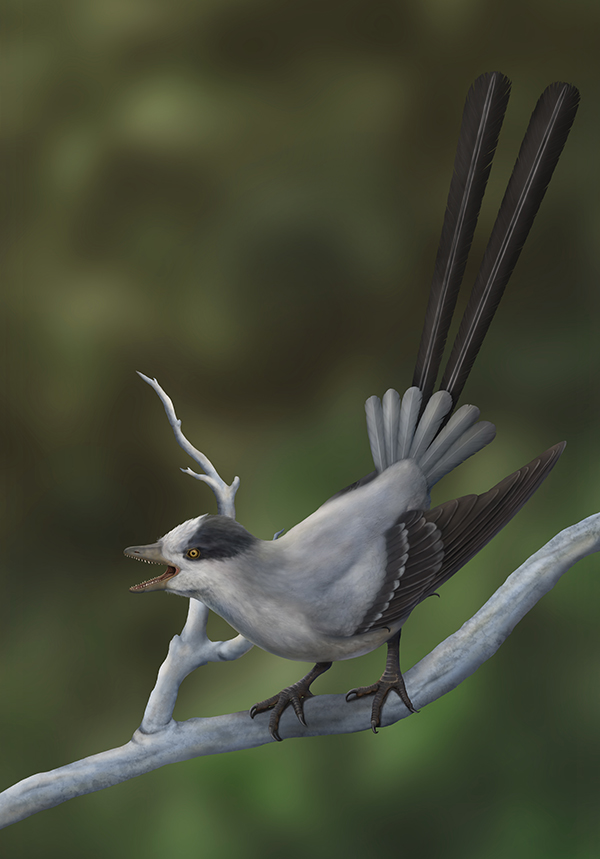| Location: Home > Research > Research Progress |
| First Enantiornithine with Pintail Elucidates Role of Sexual Selection in Early Bird Plumage |
|
Do you still remember the first time you saw a male peacock show off his beautiful, extravagant tail feathers to potential mates? What was your reaction? Astonished, for sure, but maybe you also wondered how this bird could survive with such costly and clumsy ornaments. Such counterintuitive features inspired Darwin to first introduce the concept of sexual selection. A new study has now added to our understanding of the importance of such plumage. Specifically, researchers have discovered a new species of enantiornithine with well-preserved tail feathers from the 120 million-year-old deposits of the Jehol Biota in northeastern China. This Early Cretaceous enantiornithine bird has provided new information regarding the diversity of tail plumages evolved by this clade of birds and also highlights the importance of sexual selection in early avian evolution. The study, published in Current Biology on Sept. 16, was conducted by Dr. WANG Min and Dr. ZHOU Zhonghe from the Institute of Vertebrate Paleontology and Paleoanthropology (IVPP) of the Chinese Academy of Sciences, Jingmai K. O’Connor from the Field Museum of Natural History, Chicago, and their collaborators from Nanjing University and Shandong Tianyu Museum of Nature. The new enantiornithine, named Yuanchuavis kompsosoura, belongs to the enantiornithine family Pengornithidae, one of the earliest diverging groups of enantiornithines. "Yuanchuavis preserves a rectricial fan combined with an elongate central pair of fully pennaceous rachis-dominated elongate plumes, constituting a tail plumage previously unknown among non-avian dinosaurs and Mesozoic birds," said Dr. WANG Min, the first and corresponding author of this study. Dr. WANG noted that this now extinct feather type featured an unusual rachis morphology. The combination of a tail fan with central paired ornaments is a morphology referred to as a pintail and is present in many extant birds such as male sunbirds. “In many living birds, the tail is functionally integrated into the flight apparatus, but because it is not necessarily for flight, the feathers of the tail are also shaped by sexual selection. This leads to the enormous diversity of tail plumes observed in extant birds, many of which exhibit aerodynamically costly extravagant ornaments in a wide array of colors,” said coauthor Dr. ZHOU Zhonghe. "The elongate central paired plumes in Yuanchuavis diverge greatly from the optimal shape hypothesized by aerodynamic theory, and therefore are most likely a product of sexual selection," said coauthor Jingmai K. O’Connor. Given the exaggerated nature of these tail plumes, Dr. WANG and his colleagues further argued that these central plumes represent an honest signal of quality that probably arose from the handicap principle, a mechanism of sexual selection by which females prefer males with a handicap because it indicates heritable viability. As the two dominant groups of Mesozoic birds, the sister clades Enantiornithes and Ornithuromorpha show contrasting tail morphotypes. In short, most Mesozoic ornithuromorphs lack elongate tail ornaments but preserve rectricial fans. This is opposite to the condition observed in enantiornithines, where the rectricial fan is rare. The new study posits that such contrasting patterns may result from ecological differences between the two clades. All known enantiornithines are considered to be arboreal, whereas early ornithuromorphs predominantly occupied semi-aquatic niches. Dense forested environments today are home to some of the most heavily ornamented birds, like birds of paradise (Paradisaeidae). Densely vegetated environments are rich in resources and also provide extensive cover and protection from potential predators. For this reason, costly ornaments may be less detrimental compared to more open littoral and lacustrine environments, which were occupied by Cretaceous ornithuromorphs. Similarly, seabirds have very little ornamentation, since their plumage is optimized for flight performance. The contrasting tail plumage between Cretaceous enantiornithines and ornithuromorphs manifests the complexity of the interplay between sexual and natural selection pressures, and ecological opportunities, mirroring what we see in modern bird diversity.
Fig. 1 Photograph of the 120 million-year-old enantiornithine bird Yuanchuavis kompsosoura with a pintail of the kind present in modern male sunbirds. (Image by WANG Min)
Fig. 2 Photograph and interpretive drawing of the tail plumage of Yuanchuavis kompsosoura (Image by WANG Min)  Fig. 3 Life reconstruction of the Mesozoic bird Yuanchuavis kompsosoura.(Artwork by ZHANG Haozhen) |

